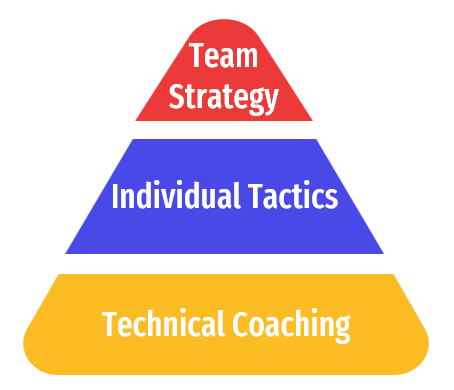Recreating Lobanovskyi’s legacy
Lobanovskyi was a legendary manager and a revolutionary thinker. While we cannot replicate everything he did, I will create a framework based on his philosophy.
Lobanovskyi was a legendary manager and created success upon success with Dynamo Kiev. His blueprint and philosophy runs deep in the Ukrainian club. While we cannot recreate everything he inspired, we will be taking the basic framework fleshing it out. He was ahead of his time in terms of using data science and most of it is applicable still today.
We will be looking at the key features of his philosophy and how it benefits your team, as well as the style of play that he favoured.
Introducing Lobanovskyi
When looking at Lobanovskyi’s style and philosophy it all boils down to three key elements. Overall team strategy, individual tactics and individual technical coaching. We are all very familiar with these elements in our day to day lives. So let’s go through each and element and what it means.
Team strategy
The overall team strategy is just that, what are we trying to achieve and how do we envisage it working. Lobanovskyi wanted to spread the attacking area to be as big as possible, and with defensive play to reduce the space the opposition could play in.
He was keen on high tempo play once the ball was won, to hit the opposition on the break, when they are in disarray. This was coupled with a high pressing movement to win the ball back a quickly as possible. In the attacking movement when a player leaves their position to attack, another player will push into the vacated space to reduce the chance of being countered.
When attacking their approach would change up between left, right or centre. It could not be a linear approach and would keep the opposition guessing while allowing a number of attacking options. The forwards would tend to split and push out wide to pull defenders around and one of the midfield would push through into the space.

Individual tactics
Each player would have tactics in how to play their position. This could change from one game to the next depending on the opposition. These instructions were really important when playing in European competition and would be the difference between winning and losing. There is not much we can speak about here as we need to know the opposition and their weaknesses.
technical coaching
This style of training is particularly important in football. It is a matter of using data in a process and understanding where the player has weaknesses and training those weaknesses out. So for example if a player has a bad shooting data, then we need to look at it logically. What type of supply is he getting? Is it his movement? Is it the shooting technique? These areas can all be worked on to make the player more effective.
The same could be said of passing. All footballers should be able to receive the ball (first touch), pass (passing) and movement (off the ball). Coaching players on these areas will significantly improve your chances of winning. The message here is that we look at the data for improvements of each player and coach them.
Lobanovskyi set pieces
Lobanovskyi saw great value in set pieces in both defence and attack. Hybrid marking was introduced, the team play zonal marking with special marking assignments to key players. He saw them as a potential avenue for more goals and winning games, something at the time which other managers did not consider.
Lobanovskyi player analysis
Some of Lobanovskyi’s philosophies were based around the 18% mistakes rule. This was something which came from his data research, he felt that a team could not lose if they made less than 18% mistakes of all actions in the game. We can use this for a number of reason, we can use this to analyse our team at the end of season against certain KPIs. We can also use this as a recruitment tool to test seasonal data with potential new recruits.
The way I intend to do this at first is with very basic data. Defenders will be judged on tackling stats, midfielders on passing and forwards on shooting data. This is very basic for now, but we will flesh it out each season to test the theory.
Conclusion
Lobanovskyi showed us a new way to think about football and he was very successful with it. If you are looking for a model to follow this could be one for you. Let’s be honest, you aren’t going to follow an unsuccessful model are you? Either way, using some of the points in this blog, you could create your own strategy and bring a club to success in FM24.
I will be creating the 4132 that he used, or at least my understanding of his strategy. As well as this I will be testing the recruitment model for Lobanovskyi’s 18% mistakes, to see if that can bring us success. This is an interesting model to follow and could change the way that I play the game. I will endeavour to post a blog with results of how it worked.
If you enjoyed this blog, please comment and give us a like. Your feedback is appreciated and helps us to grow the site.



